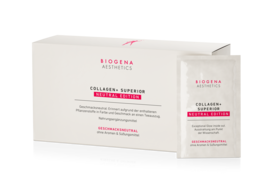Collagen is supposed to smooth our skin, make our joints resilient and tune our body composition. But what exactly is collagen? What effect does it have and how is it best used?
What is collagen?
Collagen is the most common protein in the human body, accounting for over 30%. This structural protein ensures the tensile strength of our connective tissue and is found wherever form and strength are required – in ligaments, tendons, cartilage, bones, periodontium, blood vessels, muscle and connective tissue and, of course, in the skin.
Together with the elastin fibres, the collagen forms a network structure similar to a rubber band, which forms the inner corset of the skin. This supporting corset provides the skin with elasticity and suppleness, thus ensuring that our skin smoothes.
Collagen effect
Collagen has a wide range of effects – it plays an important role in the skin, connective tissue, bones, muscles, joints and blood vessels.
Skin
Collagen (type 1 & type 3) is the main component of our skin, making up around 80% of it. Together with elastin, collagen forms the supporting structure that gives our skin and the underlying connective tissue firmness and elasticity. In addition, the collagen fibres plump up the skin from the inside due to their ability to bind water.


Decline in the body's own collagen production with age
From the age of 25, the body's collagen production slows down. In addition, the collagen fibres in ageing skin become thicker and shorter, which leads to a loss of collagen type I and to a change in the collagen type ratio Over the years, this results in a loss of stability in the deeper layers of the skin, which is also reflected externally. The skin becomes less firm, wrinkles appear and the skin's moisture level decreases. This is precisely where collagen supplements come in, providing the nutrient from the outside in a targeted manner to strengthen the collagen structure again.
Clinical studies have now also confirmed that a targeted collagen intake can reduce the visible signs of natural skin aging. For example, a 12-week intake of 10 g hydrolysed fish collagen (Naticol®) resulted in a 35% reduction in wrinkle values compared to the baseline. At the same time, the study participants reported, among other things, a 23% increase in elasticity and a 25% increase in skin firmness compared to the placebo group.
Connective tissue – cellulite
Collagen not only makes facial skin smoother, but may also be able to tighten our connective tissue. Like our skin, our connective tissue consists largely (80%) of collagen. Initial studies suggest that collagen, thanks to its firming effect, can actually reduce dimpling on the thighs and buttocks, at least when taken over the long term (6 months).
Hair
Whether collagen can also help to make beautiful hair must first be researched in clinical studies. The assumption that the structural protein could ‘tune’ the beauty of our hair is – at least theoretically – not completely far-fetched. After all, collagen not only supplies amino acids that our body can use to build hair protein. By improving the skin, it could also strengthen the hair follicle.
Muscles
In the fitness and health scene, collagen is becoming an insider tip for muscle building. After all, the structural protein is said to optimise regeneration after a workout and make muscles grow. The first scientific studies now confirm that there is more than just hot air behind the trend. In one study, for example, the targeted intake of collagen in combination with strength training promoted the build-up of lean mass (e.g. muscles, tendons) and increased muscle strength.
Joints, cartilage and bones
Collagen is also a key player in other structures of the musculoskeletal system. As an elementary component of cartilage (type II), ligaments, tendons and bones (type I), it helps to keep these body structures stable and healthy. Over the years, the body's own collagen production dwindles and with it, among other things, the resilience of the cartilage. To counteract arthritis, a targeted collagen intake can be useful. Studies suggest that collagen intake can help improve joint function and reduce joint pain and stiffness.
Bowel
It is less well known that collagen also plays a role in the bowel. A good supply of collagen contributes to an intact intestinal barrier and to the regeneration of the bowel.
Does collagen cause weight gain?
No, collagen does not make you gain weight. Weight gain occurs when you consume more calories than you burn, and collagen does not contain excess calories. However, when used correctly in conjunction with strength training, the structural protein can help athletes, both male and female, to build muscle.
Types of collagen: type 1, 2 and 3
The human body contains a total of 28 different types of collagen, which differ in their composition, structure and function. The three most important collagens are types 1, 2 and 3.
| Occurrence in the body | Functions | Interesting facts | |
| Collagen type I | Skin, tendons, fascia, bones, vessels, teeth | Provides elasticity and firmness to skin, ligaments and tendons. Gives the bone stability and flexibility. | Is the most common type of collagen in the body. |
| Collagen type II | Vitreous body of the eye, intervertebral discs, 50% of all proteins of the cartilage | Gives the said structures their stability. | Is the main collagen of cartilage (80%). |
| Collagen type III |
Skin, cornea, internal organs, uterus, vessel walls |
Provides elasticity in said tissues. |
Often combined with type I collagen in the body. |
Collagen supplements that use collagen type I are ideal for the beauty care of mature skin and also for the preventive support of younger skin. Preparations with collagen type 2, in turn, ideally support cartilage and joints.
Collagen deficiency – what are the symptoms?
From the age of 25, the body's own collagen production decreases by about 1.5% annually. This is a natural process and should not be seen as a collagen deficiency. However, certain lifestyle habits, an unhealthy diet, but also environmental factors and genetic predisposition can accelerate collagen breakdown even more. Collagen robbers include stress, alcohol, smoking, sugar, too much unprotected exposure to the sun (UV radiation), chronic illnesses and the menopause.
Not enough collagen in the body? This is how you recognise it.
Your skin becomes drier and thinner, loses firmness and elasticity and develops wrinkles. But your connective tissue also suffers from this development, with bones and cartilage becoming more brittle and tendons and ligaments losing their elasticity. All of this can manifest itself in weak connective tissue, painful joints and injury-prone tendons and ligaments.
Can collagen requirements be met through diet?
If you want to improve your collagen intake, you can resort to special foods and dietary supplements. Collagen is an animal protein that does not occur in plants. However, plant-based foods can provide building blocks for the body's own collagen synthesis. Quinoa, chia seeds, gelatine, bone broth, fish and chicken (including the skin), for example, are particularly high in collagen building blocks and collagen.
The body's own collagen production also requires zinc, which is found in seafood, nuts, seeds and whole grain products, for example, as well as vitamin C from fruit and vegetables.
How helpful is collagen supplementation?
A targeted intake can counteract the natural decline in production that occurs after the age of 25. An increasing number of studies now confirm that the targeted intake of collagen can actually help to strengthen certain collagen-rich body structures (e.g. skin, joints) and keep them healthy. For the structural protein to be effective, the supplement used should contain hydrolysed collagen.
Intake & daily requirement
How much collagen per day is recommended?
The recommended daily dosage can vary depending on the preparation and the reason for use. To improve skin hydration and elasticity and reduce wrinkles on the face, 5-10 g of collagen type I peptides (Naticol®) daily is usually recommended.
Should collagen be taken in the morning or evening?
Collagen can generally be taken at any time of the day. While some people take it on an empty stomach in the morning, others prefer an evening intake. Ideally, the timing should fit well with your daily routine to ensure consistent daily intake, as long-term and regular use is important for the desired results. A flavorless collagen powder is perfect for so-called glow coffee and can easily be integrated into a routine—just like liquid collagen ampoules, which can be consumed as a shot or mixed into other beverages.
How long should collagen be taken for?
How long you need to take collagen for visible or noticeable results depends on the reason for taking it. To achieve a positive change in the appearance of the skin, you should expect to take it for 8 to 12 weeks; initial improvements can be felt and seen after just 2-4 weeks. For lasting effects, it is essential to take it over the long term.
Collagen during pregnancy and breastfeeding
Since there have been no clinical studies on the targeted use of collagen during pregnancy and breastfeeding, it should not be taken during this special time or only in consultation with the treating medical professional.
Collagen & menopause
During the menopause, the female body undergoes a major hormonal upheaval. This internal change is also reflected in our external appearance. For example, the falling oestrogen level leads to an increased breakdown of collagen and elastin in the skin. At the same time, the amount of plumping hyaluronic acid steadily decreases. These changes cause the skin to lose firmness and volume, the contours appear saggier and wrinkles become more pronounced. The targeted intake of collagen can help restore a more youthful glow to mature skin. For example, one study showed that a targeted 12-week intake of 10 g hydrolysed fish collagen (Naticol®) combats the visible signs of skin aging. Wrinkles were reduced (-35%), and the skin regained elasticity (+23%) and firmness (+25%).
Conclusion: collagen is the superhero that holds our body together. As we age and our body's own collagen production decreases, a collagen supplement with good bioavailability can counteract this natural process. High-quality collagen supplements can help restore a more youthful glow to our appearance – especially to our skin – and, as a side effect, support the vitality of many body structures (e.g. muscles, cartilage, ligaments, tendons).
Frequently asked questions about collagen
Quinoa, chia seeds, gelatine, bone broth, fish and chicken (including the skin), for example, contain particularly large amounts of collagen building blocks and collagen.
A good supply of collagen contributes to an intact intestinal barrier and to the regeneration of the gut.
Collagen can be taken at any time of day. It is best to choose a time that fits well into your daily routine and when you would not normally forget to take it.
Collagen provides elasticity and firmness to the skin and connective tissue, but also to bones, muscles, tendons, ligaments, blood vessels and teeth.
In principle, anyone can take collagen. However, people who are allergic to fish and fish ingredients must not take fish collagen. Preparations containing fish collagen are subject to labelling requirements and must therefore indicate the allergen on the label. There are no studies on its use during pregnancy and breastfeeding, so it is not recommended during these periods.
Taking collagen helps prevent the natural age-related decrease in the body’s own collagen production and the associated loss of elasticity and moisture in the skin. More and more studies have now started to confirm that the targeted intake of collagen can actually contribute to the strengthening and maintenance of certain collagen-rich body structures (e.g. skin, joints).
Collagen should be taken for several weeks to months for noticeable or visible results, depending on the reason for use. The first improvements in skin texture can be seen after 2-4 weeks. Long-term use is essential for lasting results.
The body's own collagen production slows down from the age of 25. That is why it is recommended to start taking collagen from this age.
Collagen is a universal protein that makes no distinction based on gender. This means that it supports everyone equally, because the production of autologous collagen decreases in everyone from the age of 25.
References:
Asserin, J. et al. 2015. The effect of oral collagen peptide supplementation on skin moisture and the dermal collagen network: evidence from an ex vivo model and randomized, placebo-controlled clinical trials. J Cosmet Dermatol. 2015 Dec;14(4):291-301. doi: 10.1111/jocd.12174. Epub 2015 Sep 12. https://pubmed.ncbi.nlm.nih.gov/26362110/
Choi, F.D. 2019. Oral Collagen Supplementation: A Systematic Review of Dermatological Applications. J Drugs Dermatol. 2019 Jan 1;18(1):9-16. https://pubmed.ncbi.nlm.nih.gov/30681787/
De Miranda, R.B. et. al. 2021. Effects of hydrolyzed collagen supplementation on skin aging: a systematic review and meta-analysis. Int J Dermatol. 2021 Dec;60(12):1449-1461. doi: 10.1111/ijd.15518. Epub 2021 Mar 20. https://pubmed.ncbi.nlm.nih.gov/33742704/
Evans, M. et al. 2021. A randomized, triple-blind, placebo-controlled, parallel study to evaluate the efficacy of a freshwater marine collagen on skin wrinkles and elasticity. Journal of Cosmetic Dermatology. 20(3):825–834. https://pubmed.ncbi.nlm.nih.gov/32799362/
Sibilla, S. et al. 2015. An Overview of the Beneficial Effects of Hydrolysed Collagen as a Nutraceutical on Skin Properties: Scientific Background and Clinical Studies. The Open Nutraceuticals Journal. 8(1). https://pubmed.ncbi.nlm.nih.gov/26267777/
De Almagro, M. C. 2020. The Use of Collagen Hydrolysates and Native Collagen in Osteoarthritis. AJBSR. 7(6):530–532. https://pubmed.ncbi.nlm.nih.gov/17076983/
Hong, H. et al. 2019. Preparation of low-molecular-weight, collagen hydrolysates (peptides): Current progress, challenges, and future perspectives. Food Chemistry. 301:125222. https://pubmed.ncbi.nlm.nih.gov/31382108/
Campos Mbg, P. M. 2015. An Oral Supplementation Based on Hydrolyzed Collagen and Vitamins Improves Skin Elasticity and Dermis Echogenicity: A Clinical Placebo-Controlled Study. Clin Pharmacol Biopharm. 04(03). https://www.mdpi.com/1420-3049/26/16/4880
Castillo-Briceño, P. et al. 2011. A role for specific collagen motifs during wound healing and inflammatory response of fibroblasts in the teleost fish gilthead seabream. Mol Immunol. 48(6–7):826–834. https://pubmed.ncbi.nlm.nih.gov/21232799/
Geahchan, S. et al. 2022. Marine Collagen: A Promising Biomaterial for Wound Healing, Skin Anti-Aging, and Bone Regeneration. Mar Drugs. 20(1):61. https://pubmed.ncbi.nlm.nih.gov/35049916/
Duteil, L. et al. 2016. SPECIFIC NATURAL BIOACTIVE TYPE 1 COLLAGEN PEPTIDES ORAL INTAKE REVERSE SKIN AGING SIGNS IN MATURE WOMEN. J Aging Res & Lifestyle. :1–9. https://pubmed.ncbi.nlm.nih.gov/24401291/
Lugo, J. P. et al. 2015. Efficacy and tolerability of an undenatured type II collagen supplement in modulating knee osteoarthritis symptoms: A multicenter randomized, double-blind, placebo-controlled study. Nutr J. 2016 Jan 29;15:14. doi: 10.1186/s12937-016-0130-8. https://pubmed.ncbi.nlm.nih.gov/26822714/
Zdzieblik, D. et. al. 2015. Collagen peptide supplementation in combination with resistance training improves body composition and increases muscle strength in elderly sarcopenic men: a randomised controlled trial. Br J Nutr. 2015 Oct 28;114(8):1237-45. doi: 10.1017/S0007114515002810. Epub 2015 Sep 10. https://pubmed.ncbi.nlm.nih.gov/26353786/
Mohammed A., He S. 2021. A Double-Blind, Randomized, Placebo-Controlled Trial to Evaluate the Efficacy of a Hydrolyzed Chicken Collagen Type II Supplement in Alleviating Joint Discomfort. Nutrients. 2021 Jul 18;13(7):2454. doi: 10.3390/nu13072454. https://pubmed.ncbi.nlm.nih.gov/34371963/
Li W, Sun K, Ji Y, Wu Z, Wang W, Dai Z, Wu G. Glycine Regulates Expression and Distribution of Claudin-7 and ZO-3 Proteins in Intestinal Porcine Epithelial Cells. J Nutr. 2016 May;146(5):964-9. doi: 10.3945/jn.115.228312. Epub 2016 Mar 30. PMID: https://pubmed.ncbi.nlm.nih.gov/27029941/
Howard A, Tahir I, Javed S, Waring SM, Ford D, Hirst BH. Glycine transporter GLYT1 is essential for glycine-mediated protection of human intestinal epithelial cells against oxidative damage. J Physiol. 2010 Mar 15;588(Pt 6):995-1009. doi: 10.1113/jphysiol.2009.186262. Epub 2010 Feb 1. PMID: PMCID: PMC2849964 https://pubmed.ncbi.nlm.nih.gov/20123783/
Wu G, Bazer FW, Burghardt RC, Johnson GA, Kim SW, Knabe DA, Li P, Li X, McKnight JR, Satterfield MC, Spencer TE. Proline and hydroxyproline metabolism: implications for animal and human nutrition. Amino Acids. 2011 Apr;40(4):1053-63. doi: 10.1007/s00726-010-0715-z. Epub 2010 Aug 10. PMID: PMCID: PMC3773366. https://pubmed.ncbi.nlm.nih.gov/20697752/
Zhu S, Huang M, Feng G, Miao Y, Wu H, Zeng M, Lo YM. Gelatin versus its two major degradation products, prolyl-hydroxyproline and glycine, as supportive therapy in experimental colitis in mice. Food Sci Nutr. 2018 Apr 16;6(4):1023-1031. doi: 10.1002/fsn3.639. PMID: PMCID: PMC6021736. https://pubmed.ncbi.nlm.nih.gov/29983966/
Asserin, Jérome et al. 2015. The effect of oral collagen peptide supplementation on skin moisture and the dermal collagen network: evidence from an ex vivo model and randomized, placebo-controlled clinical trials. Journal of cosmetic dermatology vol. 14,4 (2015): 291-301. doi:10.1111/jocd.12174 https://pubmed.ncbi.nlm.nih.gov/26362110/
Damodarasamy, Mamatha et al. 2014. Hyaluronan enhances wound repair and increases collagen III in aged dermal wounds. Wound repair and regeneration: official publication of the Wound Healing Society [and] the European Tissue Repair Society vol. 22,4 (2014): 521-6. doi:10.1111/wrr.12192 https://pubmed.ncbi.nlm.nih.gov/25041621/
Clark, K.L., et al. 2008. 24-Week study on the use of collagen hydrolysate as a dietary supplement in athletes with activity-related joint pain. Curr Med Res Opin. 2008 May;24(5):1485-96. doi: 10.1185/030079908×291967. https://pubmed.ncbi.nlm.nih.gov/18416885/
Dressler, P. et al. 2018. Improvement of Functional Ankle Properties Following Supplementation with Specific Collagen Peptides in Athletes with Chronic Ankle Instability. J Sports Sci Med. 2018 Jun; 17(2): 298–304. https://pubmed.ncbi.nlm.nih.gov/29769831/
Flexikon Doccheck 2024 Access: https://flexikon.doccheck.com/de/Kollagen










